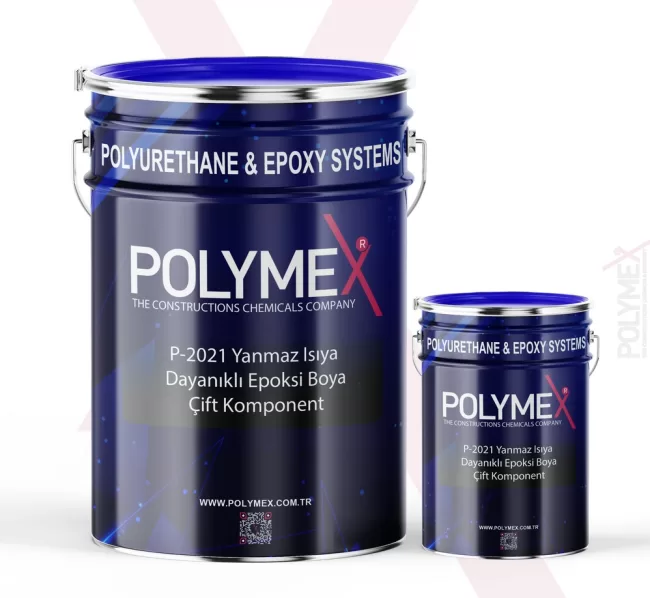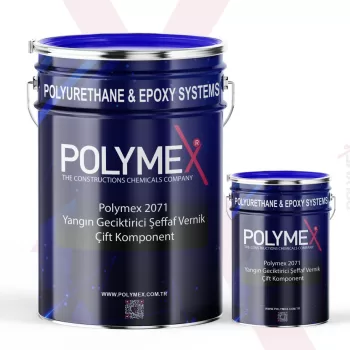Heat Resistant Fireproof Epoxy paint It shows excellent adhesion to concrete and wood surfaces. Does not crack, spill or blister. On all kinds of walls and wooden surfaces in the interior of buildings. Especially on fire escapes, steel structures, hospitals, schools, airports where the risk of fire is high, 2 coats are applied appropriately. When the fire or heat source comes into contact with the surfaces painted with Heat Resistant Fireproof Epoxy paint, the film layer cuts the heat and mass transfer to the main substrate. With the end of the burning materials, the fire ends. It does not carry flame in any way. When a material that burns for 5 minutes during a fire is painted with Polmex-20031, this time finds 2 hours Heat Resistant Fireproof Epoxy paint.
FIRE REACTION EXPERIMENT
Heat Resistant Fireproof Epoxy Paint: Classification according to TS EN 13501-1:2013 standard as a result of Fire Resistance Tests performed at TSE Istanbul Ex Laboratory: B S1 d0 (with 25 µ thickness application on 1 mm thick sheet metal). Fireproof Heat Resistant Epoxy paint
Areas of Use:
Heat Resistant Fireproof Epoxy Paint: It is safely applied on surfaces in contact with high temperatures. It is used for painting the surfaces of chimneys, furnaces and motor hair steel buildings. The surfaces to be newly applied must be cleaned very well. Better results are obtained if a thin coat is applied and a second coat is applied on it. 450 oIt shows heat resistance up to C. Fireproof Heat Resistant Epoxy paint
Passive systems differ from active systems in that they work without the need for any trigger. Such as fire-resistant doors, barriers and protection of structural steel. The operation of passive systems is spontaneous during a fire. For example, a paint that protects structural steel swells during a fire to form an insulating layer on the steel, which delays the heat from reaching the steel. Heat Resistant Oil Paint
What is Fire Retardant Paint?
Heat Resistant Fireproof Epoxy Paint Fire retardant paints are similar to normal paints in appearance. They are stable at ambient temperature. However, as a result of a series of chemical reactions during a fire, they swell up to 3 - 4 times their application thickness and form an insulation layer on steel.
Heat Resistant Oil Paint was tested on hollow and solid body columns up to 30 minutes according to EN-13381 and was successful. The paint thickness to be applied on the steel element can be calculated by knowing the following values in the light of the data obtained from the tests: Fire Retardancy Time (30 min.- 180 min.) Heat Resistant Oil Paint Since the purpose of fire retardant paint is to prevent the heat from passing to the steel, it is important that the insulation layer formed by the deterioration of the paint during the fire does not separate from the steel surface. Paint that does not adhere to the steel surface will not be able to perform its insulating function. In addition, one of the biggest problems that the paint has to cope with during the heat is to tolerate the displacements on the steel caused by the temperature. The primer is the layer between the fire retardant paint and the steel surface. If the primer separates from the surface with increasing temperatures, the fire retardant paint on it will also separate and the paint will not function. Therefore, primers approved by the manufacturer must be used. The top coat of oil paint is necessary to protect the fire retardant paint from external factors. Fire retardant oil paint can delay fire for 1 hour according to EN 13381 when evaluated according to 450 oC limit temperature. When evaluated according to 450 oC limit temperature, it can delay fire for 1 ½ hours according to EN 13381. Paint can remain on steel for 1 ½ hours. With these features, the paint is among the most advanced products in the world. Fireproof Heat Resistant Epoxy paint.
What do fire retardant paints do?
It produces fire retardant paints for the protection of structural steel. During a fire, the ambient temperature can rise from 20oC to 1000oC in a few minutes. The increase in temperature causes the temperature of the steel, which is the carrier of the structure, to increase. Steel loses its strength at high temperatures. At 600.oC, steel loses half of its carrying power. After 855.oC, buckling starts in the bearing steel. After this point, the structure faces sudden collapse. The current fire regulations in Turkey require protection with materials tested according to TSE or EN standards so as not to exceed 600.oC on the carrier steel. It is not used at these degrees.
















Reviews
There are no reviews yet.